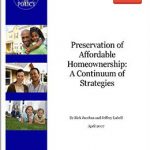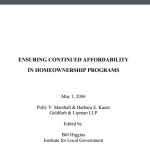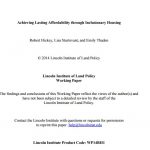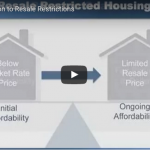This report by the National Housing Conference’s Center for Housing Policy compares the range of affordability preservation mechanism used to protect public investment in affordable homeownership units. View Report
For rental units, affordability is generally protected through a deed restriction or covenant which imposes both maximum rents and tenant eligibility standards for a fixed period of time.
For homeownership units, most communities use some form of the shared equity homeownership model to protect affordability. Some shared equity programs rely on loan documents that require owners to repay a share of appreciation. Others record deed restrictions or covenants requiring homebuyers to resell for no more than an affordable price for a future lower-income homebuyer, which is determined by a shared equity resale formula. Similarly, some programs rely on ground leases utilized by community land trusts, a nonprofit partner. Ground leases also use a formula to restrict resale prices to preserve affordability.
Davidson, North Carolina
In Davidson new inclusionary homeownership units are priced so that they will be affordable to households earning less than 120 percent of the median income. When a family chooses to sell, the city’s deed restriction requires that they notify the city before attempting to market their home. The city has the right to purchase their home at a price determined by a formula spelled out in the deed restriction.
In almost all cases, the city assigns this right to another lower-income, eligible buyer. In this case, the formula allows the home’s price to rise only as fast at the annual change in the area median income. For a family selling after 10 years, this annual increase might yield tens of thousands of dollars upon resale (in addition to the return of the family’s down payment and the amount paid off their mortgage loan). But by limiting the seller’s proceeds, the home is able to stay affordable to help a new family earning below 120 percent of AMI.
Shared Equity Resale Formulas
Most inclusionary housing programs use resale restrictions to ensure that whenever a home is resold during the affordability period, it is sold at an affordable price. While programs use different resale formulas, most programs seek to balance two goals: allowing the homeowner to benefit from some price appreciation in order to accumulate wealth; and keeping resale prices affordable for subsequent low- and moderate-income homebuyers.
The choice of resale formula has implications for advancing racial equity. Homeownership has traditionally been a main method of wealth-building for American households. Yet Black, brown and other homeowners of color have not realized the same gains as White households, due to both systemic exclusion from homeownership and lower gains in property values. Inclusionary housing programs can put homeownership opportunities in reach for low-income households of color.
Different programs give different priority to wealth accumulation and affordability preservation, depending on local market conditions and the characteristics of targeted households and/or neighborhoods.
A program that uses a resale formula that provides more equity to the seller upon resale (placing greater emphasis on wealth-building) runs the risk that significant additional subsidy could be needed to help keep the home affordable to the next buyer, or that without additional subsidy the home may lose affordability. On the other hand, a program that uses a resale formula that keeps more of the appreciation in the home (placing greater emphasis on long-term affordability) provides less wealth-building opportunity for each individual homeowner. Priorities should be informed by feedback from local racial equity organizations and people of color.
Twin Cities Habitat for Humanity* has a resale formula that places greater emphasis on wealth-building. Under their shared equity formula, the share of appreciation that the homeowner receives increases for every year that they own the home.
San Mateo, CA’s Below Market Rate (Inclusionary) Program uses an AMI-based formula, where the resale price is based on the change in Area Median Income. This formula places greater emphasis on long-term affordability.
Index Formulas
One popular approach to setting a resale price is the index-based formula. Typically the program will set the resale price equal to the original affordable purchase price plus a set rate of appreciation tied to changes in area median income (AMI) or the consumer price index (CPI).
Washington, DC, calculates the change in AMI based on a 10-year rolling average, which helps prevent a situation in which a homeowner would have to sell at a loss due to a short-term dip in AMI or sell at a price that is unlikely to allow the subsequent homeowner any price appreciation because of a short-term spike in AMI.
The AMI-based appreciation model is one of the most intuitive approaches from a long-term affordability perspective, as it ensures that the home price will still be affordable to the same targeted income group in the future. The AMI-based index formula does not, however, ensure that basic homeownership cost assumptions will remain constant over time.
Fixed-Percentage Formulas
Some jurisdictions use a fixed-percentage formula whereby the resale formula is determined by adding a pre-determined percentage increase to the original purchase price each year. This approach is simpler to explain to potential homebuyers and affords homeowners greater certainty about what to expect at the point of resale.
Park City, Utah allows an annual appreciation rate of 3 percent, though if market values in the city appreciate less than 3 percent annually, the inclusionary homeowner is limited to the rate of citywide market appreciation.
Boulder, Colorado uses a hybrid approach in an attempt to strike the right balance in their community. The program ties the resale price to an annual appreciation factor based on whichever index—the AMI or CPI—grew at a lower rate over the ownership period, but it also caps the price increase at 3.5 percent.
Appraisal Based Formulas
Burlington, Vermont, Chicago, llinois, Santa Fe, New Mexico, and Chapel Hill, North Carolina use appraisal-based (market-appreciation) formulas. Under this structure, the resale price is set based on the original price plus a percentage of the difference between the home’s original appraised value and the appraised value at the time of resale. Localities often set limits on the maximum allowable appreciation. In Burlington, for example, the resale price can be increased by 25 percent of the home’s market appreciation (as determined by appraisals).
In most cases, programs also allow the homeowner to increase the resale price to reflect the value of major repairs or other permitted improvements made by the homeowner during ownership, which helps to maintain the quality and condition of the affordable housing stock.
This type of formula is most tied to the housing market, which means it is also affected by the systemic racism inherent in the housing market. For example, homes in neighborhoods where the population is predominantly people of color have been shown to appreciate less than comparable homes in neighborhoods where the population is mostly White. This type of formula is also less predictable than other formulas. Partly for these reasons, many jurisdictions are moving toward a fixed-percentage formula.
Common Questions
Some of the most compelling arguments for the need to ensure permanent affordability have come from analyses of federally-subsidized rental units (e.g. Project Based Rental Assistance).
According to an analysis by the National Low Income Housing Coalition (NLIHC), nearly half a million of the nation’s 1.4 million federally assisted rental units are at risk of leaving the affordable stock because of “owners opting out of the program, maturation of the assisted mortgages, or failure of the property under HUD’s standards.” NLIHC advocates for the need to preserve these existing units, pointing to research that indicates that it cost 40 percent less to preserve an existing affordable unit than to build a new one.
At the same time, if one goal of an inclusionary housing program is to create economic integration, we can only hope to maintain that economic diversity if we preserve the affordable housing units over a very long time. Inclusionary housing produces new housing relatively slowly, over time as communities grow. Inclusionary housing programs can build up sizable portfolios of homes in every part of the community, but if units are only maintained as affordable for relatively short periods of time, the most desirable locations are likely to remain out of reach for lower-income residents.
Nothing lasts forever, but many cities attempt to structure their inclusionary housing policies to preserve the affordable homes for as long as possible. Many argue that if inclusionary housing programs are to create and preserve mixed-income communities, long-term restrictions are necessary for the program to have a lasting impact. If homes expire out of the program after a few decades, the program can never really address the need for affordable housing.
Ownership programs typically record deed restrictions or covenants that limit sale or rental of a regulated unit only to approved low-income (or moderate-income) households. In some communities, these covenants are structured to run ‘in perpetuity.’ In others, they have a fixed term, generally somewhere between 30 and 99 years.
Affordability terms applied to rental developments are a bit more complex. An investor might pay more for a property with rent restrictions that expire after 15 years than one with 99-year restrictions, but the difference might be slight. In other words, the length of affordability makes a big difference to the long-term impact of the program and, at most, a small difference to initial feasibility.
The best practice is to record fixed, but long-term restrictions (50 or 99 years, for example) and re-record them and ‘reset the clock’ each time a property is sold or redeveloped. For example, if a property is sold 20 years after initial development, a new restriction is recorded with a new 50-year term. If the restrictions last approximately as long as the useful life of the buildings, there is a high likelihood that affordability will be maintained over time.
For homeownership units, the affordability restrictions can be reset each time a unit is resold. Rental properties may not sell as frequently, but eventually they will be torn down and rebuilt and the jurisdiction would be in a position to require new affordable units at that point.
Permanent affordability is frequently the goal for inclusionary housing programs, and a number of communities record affordability restrictions that are perpetual and ‘run with the land.’ However, legal concerns are often cited as reasons not to adopt perpetual restrictions. For several jurisdictions, this problem is solved by simply changing the term used. Davidson, North Carolina, Chapel Hill, North Carolina, Burlington, Vermont, San Mateo, California, and Redmond, Washington all chose to define their affordability term as “the life of the building” or 99 years, rather than “in perpetuity.”
Another way that programs get around concerns about “perpetual affordability” for single-family homes is to adopt control periods of 30 or more years and require that these terms restart for the next homebuyer if the home is resold within the control period. The administrators of programs in Montgomery County, MD, Fairfax County, VA and San Mateo believe, plausibly, that this reset requirement will have the same impact as “perpetual” affordability requirements, because most homes tend to be sold within 30 years.
Fairfax County uses its preemptive option to purchase homes at the first sale of the home after the control period expires. The preemptive purchase option is another way to protect inclusionary housing units and to extend their affordability in perpetuity; however, the jurisdiction must purchase the home at market price and then subsidize it to make it affordable, which can be very expensive and therefore reduces the impact of the original subsidy.
Another approach is to require repayment of a portion of sales proceeds in excess of the affordable price when a home reaches the end of the affordability period and is sold on the open market. Montgomery County and Fairfax County capture half of these proceeds if the home sells after the completion of the 30-year affordability term. Jurisdictions in New Jersey capture 100 percent of the difference between the affordable price and market price, but this is calculated as the difference that existed at the time of initial sale. In other words, these communities capture 100 percent of the original affordability subsidy.
Setting resale prices must balance the goal of preserving affordability and allowing homeowners to build equity. It is a good policy for cities to periodically reexamine their resale formulas. However, changing a resale formula has serious implications for the ability of the program to maintain long-term affordability and could impact marketing and financing and other elements of a program. Before changing the resale formula, cities should consider conducting an analysis that compares several alternative resale formulas side by side under several possible economic scenarios.
Resources
Ensuring Continued Affordability in Homeownership Programs
This report by two California attorneys describes in detail the proven mechanisms that local governments have used to protect long-term affordability of below market-rate homeownership units. The report includes case studies of successful litigation over the enforcement of affordable homeownership restrictions. View Report
Achieving Lasting Affordability Through Inclusionary Housing
This paper analyzes a set of 20 inclusionary housing programs to highlight how long affordability periods, strong legal mechanisms, carefully designed resale formulas, dedicated program stewardship, and strategic partnerships can help preserve affordable homes. View Paper
Video Learning Series: Resale Formulas
Grounded Solution Networks’ Video Learning Series offers an in-depth 60 minute course on developing an effective formula to preserve long term affordability for affordable homeownership units. View video






